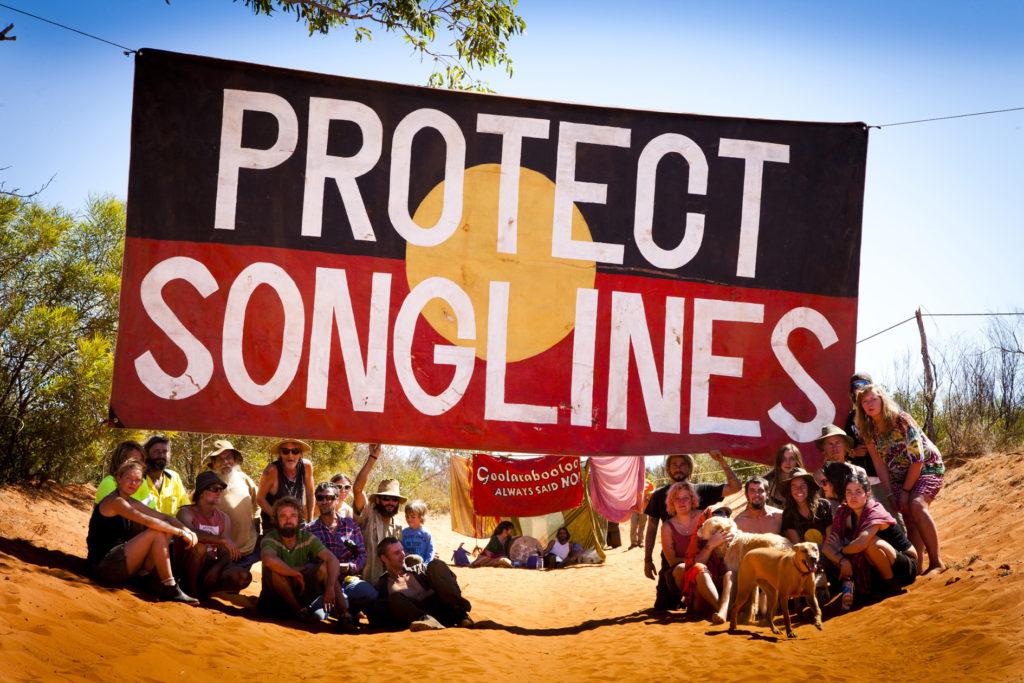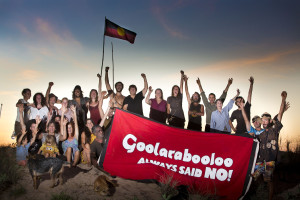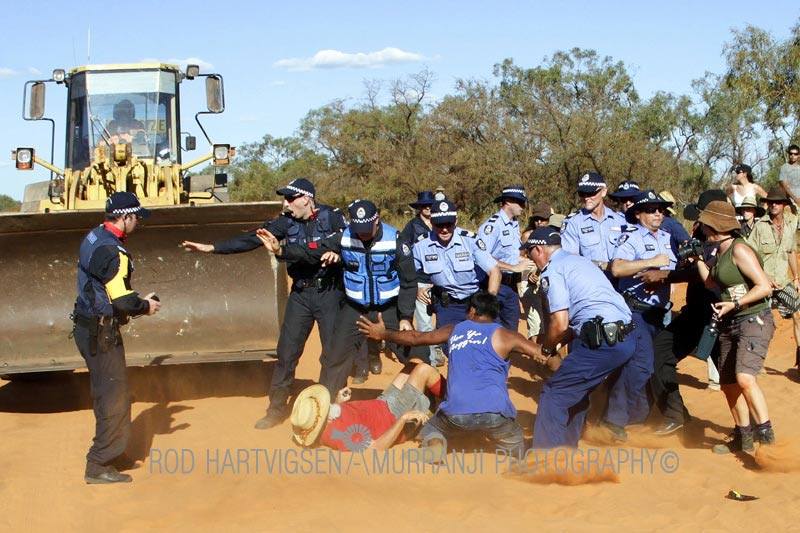
The people of Broome in the Kimberley region of Western Australia won a significant campaign against a proposed $45 billion project. In April 2013 they stopped the development of a gas plant and port at iconic James Price Point (Walmadan).
They had substantial political and corporate interests arrayed against them:
- the world’s largest multinational oil and gas companies,
- a determined state government as proponent who deployed police, and changed laws to suit, and
- a federal government unwilling to intervene.
We visited the ‘Broome No Gas’ community campaign several times, since first being invited to run nonviolent direct action training in 2011. An inspiring and ultimately successful campaign – you can read about their significant win here. We developed and contributed to this excellent camp booklet which may be helpful for many other campaigns also.
Campaign strengths
In extensive interviews and discussions with community members, the strengths of the campaign were repeatedly stated as:
- The sense of community – which encouraged broad participation, mutual support and a strong commitment to achieving the campaign outcome
- The diversity of the campaign – both in the range of people who participated, and in the tactics used. This included a variety of stakeholders: national, local and international NGOs, traditional owners, local residents, community members across Australia. They used a variety of tactics and strategies, such as:
- nonviolent direction action to delay the development,
- media leverage and community building,
- political and corporate lobbying,
- targeting the project’s investors, and
- legal interventions.
Traditional owners stood with local nurses and tradies. Environmentalists from around the country, and across the world came to stand with local business owners. The campaign was supported across the country by the Australian Conservation Foundation, Sea Shepherd, The Wilderness Society and Save the Kimberley, to name a few. However, it was strongly led by local people – both in town in the Broome Community’s No Gas campaign, with Environs Kimberley, and out ‘on country’ from the base camp Walmadan.
“This was a multi-faceted, organic campaign, fuelled by creativity, ingenuity and a fierce sense of independence and justice. It was driven locally, with national and international support. The significance of what has happened has yet to resonate across the nation, but you can be sure it’s resonating in boardrooms across Australia and overseas. When a community stands up to protect itself against a bad proposal, it can win.”
Martin Pritchard, Director, Environs Kimberley.
Impact of the campaign
The campaign operated in an extremely hostile political environment. The State Government was the subject of several court cases. The campaign was not won by political pressure, but through corporate pressure relating to direct actions, legal tactics and investor lobbying that cost the company money, time, and social license.

Whilst Woodside is on record as stating that they pulled out for ‘economic reasons’, they also admitted that the delays and obstructions of the campaign cost them significant time and money. We may never know the extent of the impact of the campaign, but it would be fair to say it was substantial in pressuring investors to exit. The delayed approval for years brought us into the changed economic climate for LNG cited as the reason for exit. It also threatened ongoing issues of ‘social license’ and threats of continual costs and delays.
Some of the features of the campaign
- A consistent direct action component which ‘blockaded’ and delayed works over many months, involving high profile local community members.
- Citizen science projects highlighted the flaws in Woodside and state government surveys in relation to whales, bilbies, turtles and dinosaur tracks. These were subsequently reported in mainstream media.
- Coordinated legal support to both challenge various internal state processes (breaches under the Aboriginal heritage act for example) but also extensive pro bono assistance in challenging the government’s compulsory acquisition of the project in the Supreme Court, amongst other things.
- High profile support of musicians, and large scale concerts and rallies organised by the Wilderness Society to galvanise city supporters, raise awareness and media.
- A committed, widespread and locally driven campaign of petitions, letter writing, social media shares and active physical presence at protests and blockades.
- A strong ‘David And Goliath’ narrative of community resistance from everyday people versus the corporate bullying, government corruption and over policing of a small town.
Variety
Some of the diverse actions of the campaign have included:
- Halloween flash mobs
- Hundreds of people facing off with riot police
- Nanas locking onto a van stopping machinery
- People handing out “Groove-On” notices at the local community festival
- Traditional Owners holding their ground reading from the UN Declaration of Indigenous Rights
- Hundreds of flowers being presented to police on Mother’s Day
… the resistance is creative, and fun, and determined.
Visibility

Images of local community members putting their bodies on the line, picked up slowly at first, were ultimately shared extensively throughout the country, and internationally. It gained widespread coverage through beautiful photography, video, clever social media, and mainstream media.
“Before my arrest, I had never even had so much as a parking fine, yet I would certainly do this again for the Kimberley, she is worth the fight and deserves the attention.”
Longtime Broome resident & business owner
This pressured the company, brought new supporters to the campaign, and reached out to those already connected. People all over the world touched by visits to Broome or walking on country became the champions for the campaign. They shared social media and built public momentum.
Later in the campaign, the West Australian published a photo of over 100 taxpayer funded police jogging as armed corporate guards through the red dirt, to ease passage for drilling equipment. This demonstrated the extent to which state government was prioritising the wealth of big business, over the wishes of the majority of residents.
“I now feel the government only cares for development and pretends to care about community and culture. I am more cynical in my attitude towards government.”
Local tradesperson, Broome
After the win
After the win, even conservative mainstream media summed up the sentiments shared by many in the public.
“It has shown the success of hardball environmentalism that is prepared to leverage community outrage, target potential financiers and fight in court. It has once again exposed the desperate lengths which politicians are prepared to go to in the name of development.”
The Australian
There were many aspects to this campaign: significant legal support in a range of areas, and in the last year or two, a growing level of support from major non-government organisations in large awareness raising events and lobbying investors. There was a cheeky Kimberley DIY ethic that saw actions take on a life of their own, a commitment to nonviolence and inspiring civil resistance, leadership from traditional owners and a genuine community solidarity from a long history of multiculturalism in Broome.
“Direct Action has empowered some people in the campaign, it has brought more media attention and has brought more people out on country.”
Broome resident, and film-maker
Keys to success
- Strong leadership from traditional owners and locals, and a well networked community able to rapidly respond to campaign situations.
- A sense of fun and creativity, and community.
- Strategic planning, a culture of training and skill sharing.
- A strong belief that the campaign is winnable and ‘we can do it’.
- Diversity of supporters and stakeholders, both locally and nationally, individually and organisations.
- Diversity of campaign tactics, e.g targeting the project’s financial partners, legal action, nonviolent direct action, citizen science and political lobbying.
- Effective use of campaign tactics to generate social and mainstream media.
Most importantly, the community genuinely believed that they could win. And they did.
This campaign was included in the report 'Creating change in Australia'. Full colour PDF available for download

Pingback: Climate activists stage protest outside #LNG18 in Perth reports @takvera